Step into History along the Ohio
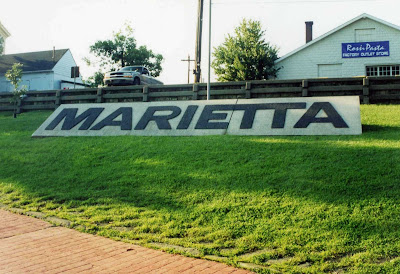
Step into History by the Ohio River
by Betty Jo Riggs, Co-editor Retirees
Stand on the levee and feel history surround you in Marietta, Ohio. Peel away the layers of years, and know this pleasant spot has afforded protection and comfort for generations before you and will for the generations to come.

It was near this spot where the first pioneers landed on April 7, 1788, led by General Rufus Putnam. These members of the Ohio Company had traveled months through the mountains between New England and the Ohio River, braving ice and snow to arrive in the spring when conditions would be right for planting their first crops. Once navigable waters were reached, the company stuffed supplies and livestock into the "Adventure Galley" flatboat and into a small flotilla of canoes and then floated towards the land where you now stand. It was here they brought their families a year later to cabins enclosed by a picket fence on two sides and the waters of the Ohio and the Muskingham which provided protection. This Picketed Point was their refuge.
Those urban planners, ex-soldiers of the Revolution, turned their army organizational skills into the building of a well-ordered town with wide streets,a grid of neat blocks, green space, and made provisions for places of worship and education. This was no ordinary outpost village even in the earliest times.
In 1825, the French general, Lafayette, surprised the people of Marietta with a visit on his tour of America. They were as hospitable to him as they have been to you. After all, they had named their fair city for his queen, Marie Antoinette. He no doubt felt at home in the classical-minded town. Greek and Latin names grace streets and buildings and even the pre-historic Indian mounds nearby. The early settlers' interest in the classics surprises the visitor.
Later, it was on this point of land that Victorian ladies and gentlemen strolled the promenade, listening to the calliope of the sternwheeler showboat which had just glided into the landing. The genteel folk who paid to see the latest play could well afford the entertainment, thanks to the affluence born of steamboat commerce and oil wells. Perhaps they, too, dined at the same hotel you did. The Layfayette Hotel is just a short stroll from the landing along a path bordered with fragrant petunias and geraniums.
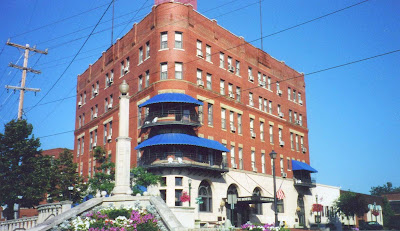
Today's tourist can find enough activity to fill several days which will enrich and enlighten. The historic Lafayette Hotel, refurbished in reproduction period furniture, provides package deals with meals in the Gun Room and tickets for nearby venues. Our room was a long expanse with a sitting room at one end and an ornately carved king bed at the other. Four long lace-dressed windows topped with jabots overlooked the Ohio and the Picketed Point. Rose-colored lamps cast a special spell.
Meals in the Gun Room, named for the historic long rifles hanging on the walls, were not only elegantly served but exceptionally good. After a crisp salad dressed with unbelievable raspberry Dijon, the personable waiter served lemon sorbet to be sure our taste buds would be ready for the main dish. That might be Chicken Picata, a shrimp/scallop/crab dish in an Alfred-like sauce, or Eggplant Parmesan in rounds that appeared like a sky-scraper model. Dessert might be a bread pudding, Key Lime pie, or cheesecake.
Another fun place to dine in Marietta is the Levee House Cafe in the oldest building on the levee. An excellent tomato-basil chilled soup and open-faced sandwich of broiled asparagus and blue cheese were good choices. An outside terrace overlooking the river or the inside dining room with its high ceilings of tin and wall displays of the Underground Railroad make this restaurant a "must" on your trip.
At the Levee House Cafe, you can catch a trolley ride for an introduction to the city on an hour-long tour at 12:30. (Adults $7.50) You'll travel the brick streets past fine Victorian homes wrapped in long porches and draped with luxuriant ferns. You'll see the Castle, a gem of Victoriana, and cross the Muskingham River to see the historic sister city of Harmar where the first fort in the Northwest Territory was located.
It's a river city, and your trip should include a tour on the Valley Gem sternwheeler. From the river's perspective, Marietta presents a different view. You can arrange either sightseeing ($11 for adults) or dinner cruises (prices vary). It's not hard to imagine the Indian attacks on the unlucky settlers on Buckley Island as you drift past. This day you might see youngsters swinging from Tarzan ropes into the Muskingham and boys who dare to swim under the bridge across the Ohio to Williamstown, West Virginia.
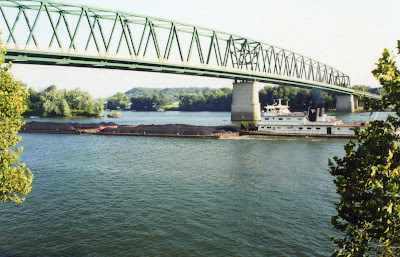
That bridge can carry you to the Fenton Art Glass factory in Williamstown. You can tour it for free, usually from 8 A.M. to 4:45 P.M. It's a ballet as the gatherers transfer molten glass to the pressers or the blowers to perform their magic on the little blob of glowing glass. You will marvel at the finished products in the gift shop where you can buy bargain seconds or signed limited editions.

While in West Virginia, you can journey a bit farther to Parkersburg and step in to yet another history-filled space. A stern-wheeler will carry you to Blennerhassett Island. Completed in 1800, the Blennerhassetts’ home was the epitome of good taste and elegance on the very edge of the frontier. After the original was destroyed by fire, another house was rebuilt on the same spot. You will learn how Benedict Arnold was associated with the Blennerhassetts.
Back in Marietta, take time to fully explore its museums, but beware that most are closed on Mondays and some also on Tuesdays. The Campus Martius Museum needs a half-day to tour. It incorporates the original home of Rufus Putnam that had been part of the fort at that location. Museum walls simply surround Putnam's two story home, preserving it for future generations. (Adults $8.00)
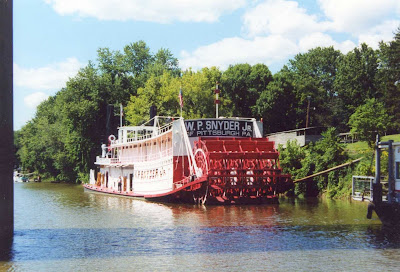
Nearby, the Ohio River Museum ($7.00 adults) offers a tour of the "W.P. Snyder", the only surviving steam-powered stern-wheel towboat. A replica of the "Adventure Galley" which floated those first settlers provides an idea of what an adventure that must have been.
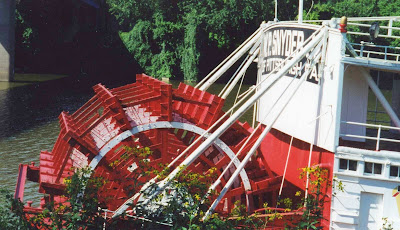
An architectural walking tour takes place on Saturdays at 10:30 A.M. at 418 Fourth Street during the summer months. Those whose ancestors entered the western frontier by way of this town will find the genealogical collection of the Washington County Public Library helpful in tracing their families. The Historical Society can provide further resources and records.
If your interests lead more to acquisitions of historical treasure, the city offers interesting antique shops. Stroll down Front Street for more shopping. Sugden's Book Store has a fine collection of books on local history. A surprising shop on the Levee is Rossi's Pasta Factory where Oprah is said to have ordered specialty pasta. No, you won't find the usual Tee Shirt store in this town, but you might splurge at the chocolate shop.
After delving into the history of this little town, a walk on the levee is even more meaningful. You'll walk with ghosts of the past and treasure the moments. The omniscient river, still busy with barges of coal and pleasure boats, continues its important role in Ohio's history.
Marietta is located just south of Interstate 77 on Ohio Route 7. Specific information about lodging and sites of interest can be found at www.mariettaoh.net, wikipedia.org, and www.marietta-ohio.com. The Marietta/Washington County Convention and Visitor's Bureau can provide further information at (740) 373-5178 or (800) 288-2577.




















Dr. Jessie Voigts
bj - this sounds just lovely. now i can't wait to go! thanks so much.
Jessie Voigts
Publisher, wanderingeducators.com